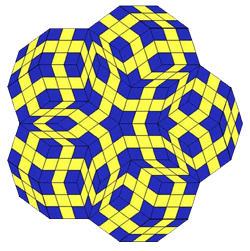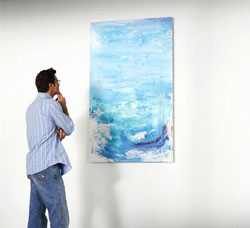wpolscemamymocneseo 2011 wpolscemamymocneseo
We Use Math Blog
Math on Display
One day, architect Paul Stacy sat down with a pile of diamond-shaped tiles, determined to create a visual masterpiece. Called Penrose tiles, these shapes come in two sizes and two colors, but there’s more to these tiles than meets the eye.

Turns out these simple diamond shapes have been the subject of mathematical theories for ages. If these tiles are assembled according to certain rules, they form a pattern that never repeats, no matter how far it’s extended. These patterns also have five-fold rotational symmetry, so the whole pattern can be turned 72 degrees and still look the same. Stacy used these tiles and their inherent mathematical properties to create a painting that was displayed at the Joint Mathematics Meetings in Washington, D.C.
Click here to see Stacy’s finished painting and to see more artwork displayed at the Joint Mathematics Meeting, including a painting based on Monge’s theorem and a sculpture inspired by a knot dipped in soapy water.
Drugs You’ll Like
Do you ever feel like computers are reading your mind?

iTunes knows your favorite song even if you haven’t heard it yet, Amazon knows what you were going to buy next, Pandora has the perfect playlist to match your day, Netflix knows what movie you’ll want to see tonight, and Facebook finds your friends before you do. How do they do it? Algorithms. These days, almost every online store, music-streaming site, online radio, and social-networking site makes recommendations using a complex and eerily accurate algorithm. Now pharmaceutical scientists are following in the footsteps of Pandora and Facebook to bring you their own recommendation lineup: “drugs you’ll like.” Learn more about the breakthrough ranking method that sorts through thousands of chemical compounds to find “therapeutic needles” in "chemical haystacks.”
Teaching a Computer to “See”
"When Dan Rockmore viewed an exhibit of drawings by Pieter Bruegel the Elder in 2001, he had no idea that his mathematical career was about to change.

"The curator pointed out faked Bruegel drawings so skillfully done that art historians had thought the imitations authentic for decades. Then she showed Rockmore minute idiosyncrasies of the pen strokes in the Bruegel drawings that were different in the fakes. His mathematical imagination was triggered. I could teach a computer to see that, he thought."
And that’s exactly what he did. Find out how this mathematician made the top science news of 2010.